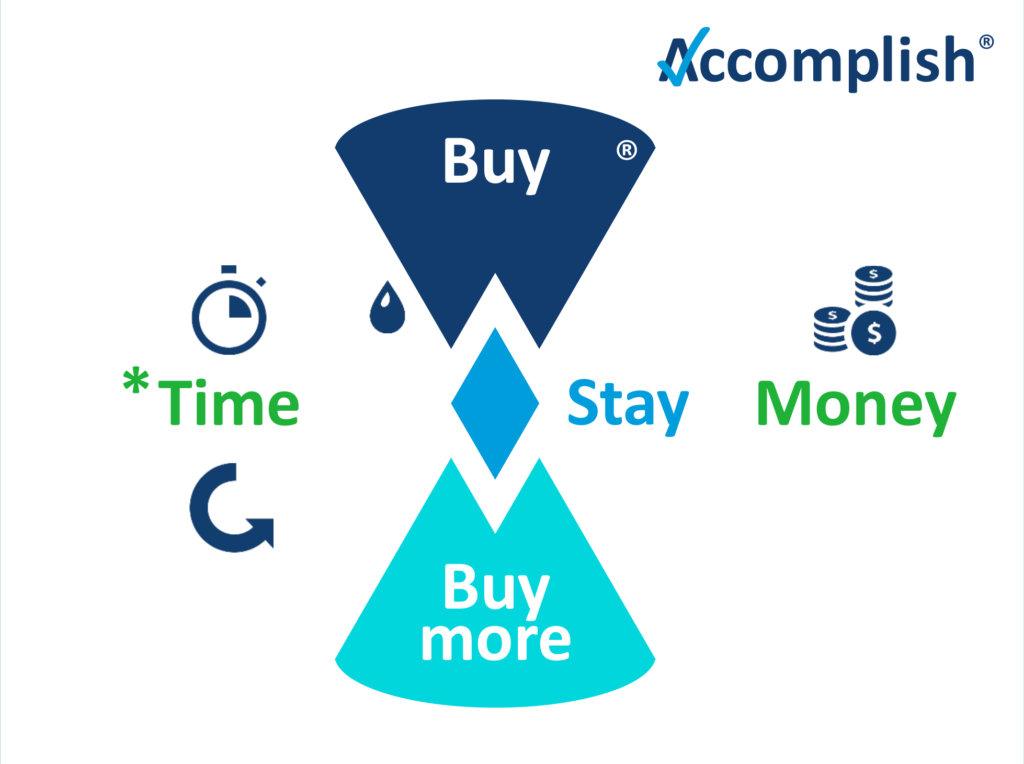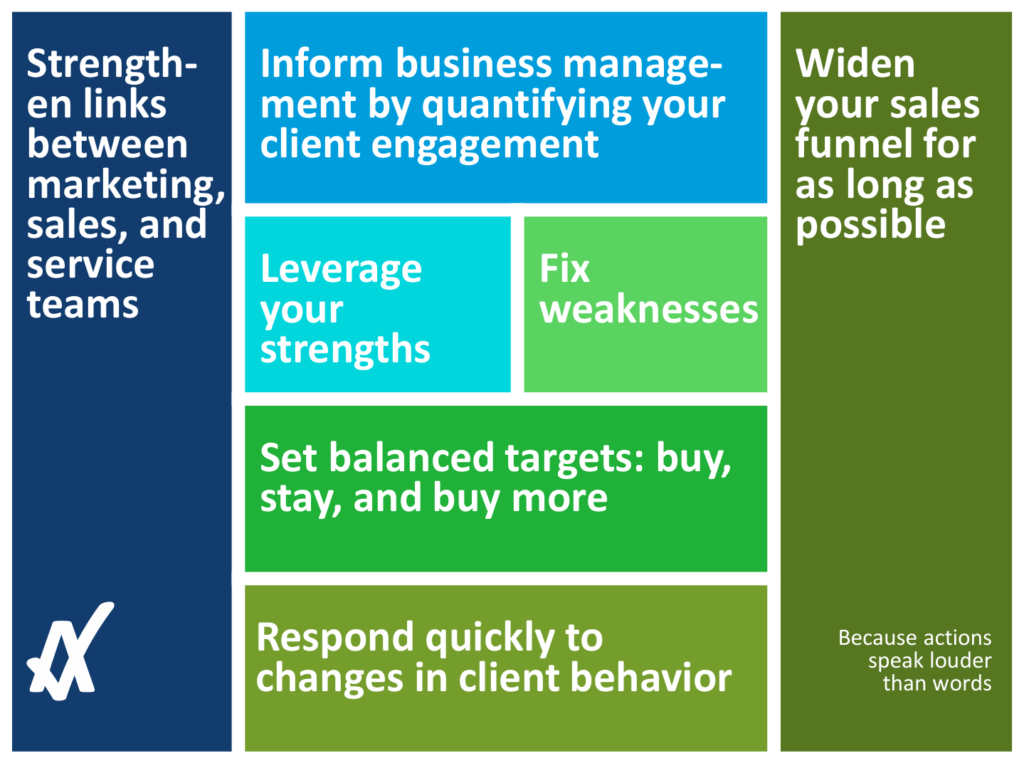In brief
From a behavioral perspective, the asset management sales funnel is NOT an inverted triangle. It is an hourglass of buying, staying, and buying more.
While this may be news to some people, it is a fact and the reason why the 7 Client Behavior Benchmark use cases will separate winners from losers.
To spread the word, this blog gives you a simple explanation of each use case. We see it as a survival guide for asset managers navigating the current market environment – and the client behavior data you need for it is literally sitting in your systems waiting to be extracted and exploited.
There will be winners and losers
As we explained in a previous article, the asset management sales funnel is NOT an inverted triangle: it is an hourglass of buying, staying, and buying more.
This is important because a traditional sales funnel that only includes ‘buying’ will expose an asset manager to the risk of lower growth: in a relational business, its focus on costly new sales activities (‘buying’) obscures cheaper processes that stimulate client retention (‘staying’) and relationship depth (‘buying more’). Despite this, much of our industry is yet to recognise the shape of its sales funnel. This presents an opportunity for those who want to seize it.
Why care about this now? In previous times, the industry has reduced sufficient costs to ride out unfavorable markets. However, if this tactical reaction is your only solution, you risk creating a vicious circle of cost-cutting for your organization. A more strategic approach would prioritise costs depending on the size of the revenue they support, the bulk of which reside in the ‘stay’ section of the Hourglass.

The client behavior data you need is literally sitting in your systems waiting to be extracted and exploited. So, while the information is abundant, it is the insights you derive from it that are scarce and valuable. As a result, the drivers of your (non-investment-related) competitive advantage, will be 1) your ability to break from the past and develop a strategic response, 2) your determination to extract the data, and 3) your ability to derive vital insights from it and respond to them more effectively than your rivals.
Because of this, at Accomplish, we believe the winners in the streamlined industry that awaits us all will be those who grasp the importance of the Hourglass and fully exploit the new use cases (below) that the Client Behavior Benchmark makes possible.
Typical buyers of the benchmark
“By codifying and quantifying the behavioral sales funnel, you have created extreme value.”
The Client Behavior Benchmark lets asset managers extract and exploit their client behavior data so they can see their effect on whether clients buy, stay, and buy more. Our typical buyers shape distribution strategy and report directly to the Head of Distribution (or equivalent). They are:
- Marketing Directors or Client Engagement leads.
- Distribution COOs or Business Managers.
- Heads of Client Insights / Business Intelligence.
What has been their reaction to the benchmark’s use cases? In the words of one of them, “by codifying and quantifying the behavioral sales funnel, you have created extreme value.”
Let’s break down this value into the 7 mutually-supportive Client Behavior Benchmark use cases
1. Set balanced targets and track progress frequently – an exclusive focus on buying behaviors was understandable in the good times but is questionable (at best) in the new economic environment. Not only would it be costly (as we have explained above), but it would be a bet that the economic tide will keep rising. When you look at it this way, you see how many asset management firms have, in practice, a blind spot to much larger and cheaper sources of revenue – their existing clients.
It’s not that they don’t know the importance of client retention and relationship depth, it’s that there was previously no way to translate this theoretical knowledge into tangible objectives. However, the Client Behavior Benchmark now exists, so you can now set and reward an informed and balanced group of targets and track your progress against them frequently.

- Sales conversion (buying) – how good is your sales capability? Absolute currency targets serve a purpose, but they will not tell you this. To stay sharp and ensure you don’t reward people for just being in the right place at the right time, measure your relative sales conversion rate. It’s like performance attribution for your sales staff.
- Client retention (staying) – revenue from retaining existing clients will almost always far exceed the additional income of recent wins. The Client Behavior Benchmark contains the industry dataset for institutional client tenure so you can discover how you are doing, set targets, and develop retention strategies. Why? Everybody talks about client retention, but the winners will measure it and derive vital insights from it.
- Relationship depth (buying more) – one of the best ways to retain a client is to deepen your relationship with them. Even small changes to your overall product-per-client ratio can bring significant commercial benefits – and at a much lower cost of sale than a narrow focus on new clients. Do your relationship managers have product-per-client targets? And, if not, why on earth not?
2. Exploit your strengths – another of our clients has referred to the benchmark’s dataset as “out- and underperformance across the everything else.” This is a fair description, but before you jump into fixing weaknesses, first exploit your strengths to the max. Ensure you are making the most out of the outperforming areas on your sales funnel. For example, let’s imagine that many more people view your recordings of investment events compared to the benchmark average. That takes time and dedication to your brand, which makes it a valuable leading behavioral indicator. In essence, these are your super fans. So, this is where you should locate your most important calls-to-action (CTAs) and your strongest behavioral nudges. And a change like this may take less time than remediating a weakness, so you will reap the rewards faster.
3. Identify and fix leaks in your sales funnel – now it’s time to work on those areas of underperformance. The great thing about the Client Behavior Benchmark is that it will pinpoint the parts of your sales funnel that are leaking clients at an abnormal rate. These may be tactical shortcomings like a below-average conversion of digital into non-digital engagement, or they may be strategic ones like retaining clients for materially less time than your rivals. The crucial point is that now you know and, armed with these insights, problems become understood and entirely solvable.
4. Strengthen links between marketing, sales, and service – in our experience, the best way to achieve this is for each team to stop wanting to be the best, highest, fastest etc on every metric in the benchmark. This is just ‘silo-mentality for chartists’. Instead, start aiming to convert one client behavior into another as efficiently as possible. Imagine a game where each team must pour water into the next team’s bucket with the winning company being the one with the most water at the end. That’s how you should view your sales funnel: it’s not about Team A or Team B, it’s about working together to ensure you minimize your client leakage. For example, should the measure of success of an investment event be the number of ‘bums of seats’, or the conversion rate to follow-on meetings with relationship managers?
5. Keep engagement on your sales funnel and client journey as wide as possible for as long as possible – this one is quite simple: every time you address an area of underperformance on your sales funnel and return to outperformance, you will, by definition, be keeping it wider and longer than your rivals. The trick is to make changes systematically so you can understand their incremental effect on how you are converting one client behavior into another. Check out the live demo on the Client Behavior Benchmark page for an example in action.
6. Quantify the revenue impact of your effect on client behavior – another unique Client Behavior Benchmark use case is your ability to use our calculators to quantify the dollar impacts of your out- or underperformance at stimulating clients to buy (sales conversion), stay (client tenure), and buy more (products-per-client). These are essential inputs to any discussion about ROI because they are the only dollarizable client behaviors on your sales funnel. As a result, you need them to establish the business case for growth or rationalisation projects.
7. Respond quickly to changes in client behavior – behaviors change, and market norms evolve. In the 2 years we have been running data through the benchmark, we have seen tactical changes in things like RFP success rates, as well as strategic alerts like quarterly client tenure flashing red because an asset manager was losing younger client relationships. Finding out early and in an evidence-based way will help you respond fast and keep out of trouble.
What are the implications for your company?
To conclude, the Client Behavior Benchmark use cases are previously unavailable capabilities that will separate winners from losers in the coming months and years.
If you would like to learn more about the benchmark and see a live demo, head over to the Client Behavior Benchmark page. When you get there, you will also be able to book a personal tour so you can discuss the implications of this industry dataset for your company.
Happy nudging, and we hope you found this article useful.




